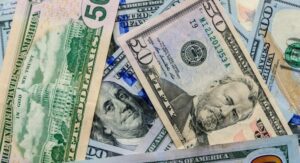
The U.S. dollar is stable against the euro in trading on Wednesday, strengthening against the pound and the yen.
The ICE-calculated index showing the dollar’s dynamics against six currencies (euro, Swiss franc, yen, Canadian dollar, pound sterling and Swedish krona) is adding 0.02% in trading, while the broader WSJ Dollar Index is losing 0.04%.
The euro/dollar pair is trading at $1.0899 as of 8:00 a.m., up from $1.0888 at market close Tuesday.
The pound is down to $1.2319 from $1.2329 the day before. The dollar fell to 130.44 yen against 130.17 yen in previous trading.
This week traders will focus on preliminary data on US GDP for the fourth quarter to be published by the US Department of Commerce on January 26. The consensus-forecast of experts quoted by Trading Economics suggests that the American economy growth slowed down to 2.6% in October-December from 3.2% in the third quarter.
The data published the day before showed a continuing weakening of business activity in the states.
The composite Purchasing Managers Index (PMI) in the U.S., calculated by S&P Global, rose to 46.6 points in January from 45 points a month earlier. A reading below the 50-point mark indicates a contraction in business activity. The U.S. PMI has remained below that level for seven months in a row.
Business activity in January continued to fall in both the U.S. manufacturing and service sectors, preliminary data from S&P Global showed.
Experts expect the weakening economic recovery to prompt the Federal Reserve (Fed) to slow the pace of base interest rate hikes.
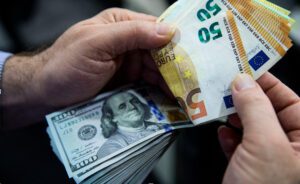
The euro, which fell below parity with the U.S. dollar in September 2022, is recovering thanks to a cooling energy market, reduced fears of recession and a hawkish stance of the European Central Bank (ECB).
The euro, which has gained almost 13% in the last 3.5 months, was also helped by a general weakening of the U.S. currency: the dollar ICE index, which rose to a 20-year high in September, has since lost about 10%.
As of 11:15 a.m. on Monday, the euro/dollar pair was trading at $1.0895, up from $1.0857 at the close of the previous session.
The Federal Reserve (Fed) raised its benchmark rate by 425 basis points last year, the fastest rate hike for a single year in four decades, the Financial Times noted. The widening of the spread between U.S. and other interest rates triggered an influx of investor funds into U.S. assets, which provided strong support for the U.S. dollar. This put additional pressure on the euro, already weakened by the rise in energy prices due to the full-scale war unleashed by Russia against Ukraine and fears of a downturn in the region’s economy.
Recently, however, trends have changed somewhat.
“For several years, there were virtually no alternatives to the dollar,” says Andreas König, head of currency markets at Amundi. – Now the capital returns to the economy outside the U.S., as there are other attractive options for investment.
In particular, the expert notes the increase of foreign capital inflow to China after the lifting of quarantine restrictions by the authorities of the country. China’s decision to abandon its policy of zero tolerance for COVID-19 provoked higher forecasts for the global economy by leading experts. This also puts pressure on the dollar, which usually strengthens in periods of macroeconomic stress.
At the same time, the outlook for Europe has recently improved, notes the FT. Gas prices have fallen due to a mild winter in the region, allowing the economy to avoid the expected deep recession.
Emerging signals of weakening inflation in the U.S. means that the U.S. Central Bank could continue to slow the pace of rate hikes. In December, the Fed increased the rate by 50 bps. – up to 4,25-4,5% per annum after its rise by 75 bp following the results of the previous four meetings.
The market expects further reduction in the Fed’s policy tightening and believes that the central bank may begin to reduce the rate in the second half of this year.
The ECB raised key interest rates by a total of 250 bps last year.
“Lower rates will eliminate a major advantage the dollar has,” said MUFG currency analyst Lee Hardman, who expects the ECB’s deposit rate to rise to 3.25 percent from 2 percent by the middle of this year. – Last year, the Fed was the leader among other global central banks in raising rates, but now the ECB has become more hawkish.
Strengthening the divergence in policy between the Fed and the ECB could lead to a rise in the euro to $ 1.12 by early 2024, said Hardman.
The expert, however, cautions against excessive optimism about the euro exchange rate against the dollar, given the continuing threat of rising energy prices that could affect the volume of European trade.
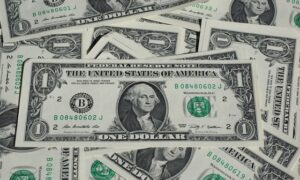
The dollar is getting cheaper against the euro and the pound sterling and is getting stronger against the yen.
Signals of a weakening U.S. economy and recent comments from Federal Reserve (Fed) leaders give investors hope that the U.S. Central Bank will continue to slow the pace of raising the benchmark interest rate.
Federal Reserve Board of Governors member Christopher Waller said last Friday that the central bank has already raised the rate substantially – and “it’s time to slow down, but not stop” its hike.
“I am in favor of a 25 basis point (bps) rate hike at this point in the Fed’s upcoming meeting,” Waller said during a speech at the U.S. Council on Foreign Relations.
“We still have a long way to go to get inflation back to the 2% target, and I believe I will support further tightening of monetary policy,” Waller was quoted by Market Watch.
Federal Reserve Bank of Kansas City (FRB) President Esther George told Bloomberg TV that while inflation has slowed, it is still well above the target.
“To stay true to our price stability mandate, we need to be a little more patient,” she said.
In December, the Fed increased the rate by 50 bps. – To 4,25-4,5% per annum after its rise by 75 bp at the end of the previous four meetings, and the market is waiting for a further slowdown in policy tightening, taking into account signals of weakening inflation and economic activity in the U.S.
The European Central Bank (ECB) may have to continue raising the rate at a rate of 50 bp in both February and March, ECB Governing Council member and Dutch central bank governor Klaas Knott told the Dutch broadcaster WNL. According to Knott, the rate hike will continue in the coming months.
In a separate interview he gave to the Italian newspaper La Stampa, Knott said that it was “too early” to talk about the possibility of a slowdown in the ECB’s rate increases by the summer.
The ECB raised key interest rates by a total of 250 bps last year. Experts polled by Bloomberg expect the ECB’s deposit rate, currently at 2 percent, to eventually rise to 3.25 percent.
The ICE-calculated index showing the dollar’s dynamics against six currencies (euro, Swiss franc, yen, Canadian dollar, pound sterling and Swedish krona) lost 0.22% in trading Monday, while the broader WSJ Dollar Index lost 0.09%.
The euro/dollar pair is trading at $1.0893 as of 8:15 a.m., up from $1.0857 at market close on Friday.
The pound/dollar exchange rate rose to $1.2415 from $1.2394 the day before.
The dollar’s value against the yen is 129.92 yen against 129.5 yen in the previous session.
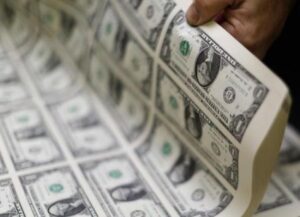
The U.S. dollar is stable against the euro in trading on Thursday, getting cheaper against the yen, despite the hawkish tone of the Federal Reserve’s (Fed) December meeting minutes published the day before.
The ICE-calculated index showing the dollar’s performance against six currencies (euro, Swiss franc, yen, Canadian dollar, pound sterling and Swedish krona) is stable in trading, while the broader WSJ Dollar Index is adding 0.01%.
As of 8:00 a.m. Ksk on Thursday, the euro/dollar pair is trading at $1.0610, up from $1.0606 at the close of the previous session.
The value of the U.S. currency in a pair with the yen dropped to 132.47 yen, compared to 132.63 yen in previous trading.
The pound to dollar exchange rate fell to $1.2040 against $1.2054 the day before.
Minutes of the December meeting of the Federal Reserve showed that none of the Fed’s leaders believes it is reasonable to reduce the benchmark interest rate in the beginning of the year, as the financial markets expect.
Meeting participants generally believed that “maintaining restrictive monetary policy for an extended period until inflation clearly moves toward 2 percent would be justified,” the minutes said.
At that, the U.S. Central Bank confirmed its desire to achieve slowdown of inflation without excessive weakening of economic activity, Bloomberg agency notes.
Heads of Fed named two main risks as preservation of the raised inflation during longer, than it is expected, interval, and also the fact that the cumulative effect from raising rates can appear with some delay and lead to excessive toughening of financial conditions.
In December the Fed raised the rate by 50 basis points (bps) – to 4,25-4,5% per annum, while at the previous four meetings the rate was increased by 75 bps. At the same time, Fed Chairman Jerome Powell said the U.S. central bank will raise the rate until it meets its inflation targets.
Investors are waiting for the U.S. labor market data for December, which will be released on Friday at 15:30 ksec. Experts polled by Trading Economics on average expect the number of jobs in the U.S. to rise by 200,000 last month and unemployment to remain at 3.7%.
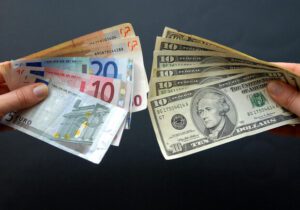
Tuesday the U.S. dollar is almost stable against the European currency and is declining against the yen.
The DXY index, which shows the U.S. dollar value against the six major world currencies, added 0.1% during the session. At the same time, indicator WSJ Dollar, which tracks the movement of the dollar against 16 currencies, dropped by a similar amount.
The euro was trading at $1.0664 against $1.0668 at the end of the previous session.
The value of the single European currency is now around 138.81 yen, compared to 139.46 yen on Monday. The dollar exchange rate is 130.18 yen against 130.74 yen at the end of the previous trading day.
The pound is trading at $1.2069 compared to $1.2048 on the previous trading day and the euro is at £0.8835 compared to £0.8856.
The euro gained 8.8 percent against the dollar in the fourth quarter of 2022, according to Dow Jones Market Data. This was the highest quarterly gain since 2010.
Meanwhile, the DXY index showed a 7.7% drop in October-December, the biggest decline in twelve years. That didn’t stop the indicator from ending 2022 on the plus side: it was up 7.9%, the highest gain since 2015.
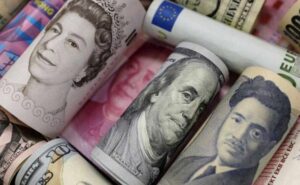
The US dollar rate was changing little against the euro and the pound during the Wednesday morning session, but demonstrated a considerable rise against the yen amid increasing US government bond yields.
The ICE-calculated index showing the U.S. dollar’s performance against six currencies (euro, Swiss franc, yen, Canadian dollar, pound sterling and Swedish krona) is up 0.1%, as is the broader WSJ Dollar Index.
The dollar/yen exchange rate is up 0.4 percent at 134.08 yen as of 7:48 a.m. ksk, up from 133.50 yen at the end of last session.
The yield on 10-year U.S. government bonds on Wednesday morning is about 3.85%, the highest since early November. The rise in yields is due to fears that China’s successive easing of anti-coverage restrictions could intensify global inflationary pressures, Trading Economics writes.
The dollar also continues to receive support from the Federal Reserve’s (Fed) hawkish mood. The Fed expects to raise its key interest rate to 5-5.25% over the next year and hold it at that level until at least early 2024 to return inflation to its 2% target.
The U.S. rate now stands at 4.25-4.5%, meaning the Fed plans three more hikes of 25 basis points. Many market participants expected the final rate level to be lower and were hoping for a reversal in the Fed’s monetary policy and a rate cut at some point next year.
The euro/dollar pair is trading at $1.0645 versus $1.0642 at the close of Tuesday’s session.
The pound sterling is losing less than 0.1% and is trading at $1.2026 versus $1.2031 the day before.